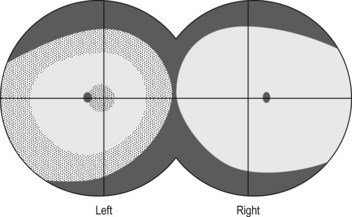43 Central scotoma
Salient features
Examination
• Central scotoma (allow the patient to find the defect by moving the white hat pin in his or her own visual field). Then determine:
Advanced-level questions
Mention a few underlying causes for central scotoma
• Demyelinating disorders (multiple sclerosis)
• Optic nerve compression by tumour, aneurysm
• Toxins: methanol, tobacco, lead, arsenical poisoning
• Ischaemia, including central retinal artery occlusion caused by thromboembolism, temporal arteritis, syphilis, idiopathic acute ischaemic neuropathy
• Hereditary disorders: Friedreich’s ataxia, Leber’s optic atrophy
• Secondary to retinitis pigmentosa
• Late age-related macular degeneration: the patient usually has enough vision to be ambulatory because the peripheral visual field around a central scotoma is intact
• Valsalva retinopathy, which is characterized by a painless, sudden loss of vision in an otherwise healthy patient with no ocular history after activities such as vomiting, coughing and weight lifting. (The sudden rise in intrathoracic pressure increased the intraocular venous pressure, causing the rupture of perifoveal capillaries.) Visual loss can be marked but spontaneous recovery usually occurs (N Engl J Med 2005;352:e16)








